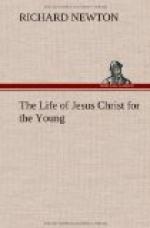Now Charley’s father, in acting as he did, was trying to make all the dumb creatures about him know that he was their friend; that he loved them, and had nothing but kindness in his heart towards them. In this way he encouraged them to come to him, and not be afraid of him.
And this is just the way in which Jesus was acting when he did and said so much to show his interest in children. He wants them all to understand that he is their friend; that he loves them, and wants them to come to him and love and serve him. And so every child who hears or reads about Jesus may feel encouraged to say:
“Once in his arms the Saviour took
Young children just like me,
And blessed them with his voice and look
As kind as kind could be.
“And though to heaven the Lord hath
gone,
And seems so far away,
He hath a smile for every one
That doth his voice obey.
“I’d rather be the least of
them
That he will bless and own,
Than wear a royal diadem,
And sit upon a throne.”
And so we may well say that in what Jesus did and said about the children there is great encouragement.
And then there are—GREAT LESSONS—too, in this part of the life of Christ.
There are two lessons taught us here. One is about the work we are to do for Jesus here on earth. When Jesus said to Peter, “Lovest thou me? Feed my lambs,” he meant to teach him, and you, and me, and all his people everywhere, the best way in which we can show our love to him. The lambs of Christ here spoken of mean little children, wherever they are found. And to feed these lambs is to teach them about Jesus. When we are trying to bring the young to Jesus and teaching them to love and serve him, then we are doing the work that is most pleasing to him:—the work that he most loves to have his people do. It was thinking about this that first led me to begin the work of preaching regularly to the young. And this is the lesson that Jesus would have all his people learn when he says to each of them:—“Lovest thou me? Feed my lambs.”
“The Angel in the Stone.” Many years ago there was a celebrated artist who lived in Italy, whose name was Michael Angelo. He was a great painter, and a great sculptor, or a worker in marble. He loved to see beautiful figures chiseled out of marble, and he had great power and skill in chiseling out such figures. One day, as he was walking with some friends through the city of Florence, he saw a block of marble lying neglected in a yard, half covered with dust and rubbish. He stopped to examine that block of marble. That day happened to be a great holiday in Florence and the artist had his best suit of clothes on; but not caring for this he threw off his coat, and went to work to clear away the rubbish from that marble. His friends were surprised. They said to him:—“Come on, let’s go; what’s the use of wasting your time on that good-for-nothing lump of stone?”




